Replacement of P&T with ORC Advanced® Reduces Cost to Closure
CASE SUMMARY
Two leaking underground storage tanks (USTs) resulted in soil and groundwater contamination at a service station in Michigan. Naphthalene, trimethylbenzene (TMB) and benzene, toluene, ethylbenzene, and xylenes (BTEX) contamination were discovered in the subsurface prompting the need for remedial cleanup. Michigan DEQ began remediation via UST removal and soil excavation. A total of 4,000 cubic yards of contaminated soil was removed. A pump and treat (P&T) system was installed and operated for 8 years through November 2003. The system removed 1,575 pounds of BTEX and significantly lowered contaminant concentrations. However, the P&T system reached asymptotic conditions and would not be effective in achieving site closure goals. Regulators began looking into new ways of accelerating the remediation process and reducing the overall cost of cleanup. Enhanced aerobic bioremediation using ORC Advanced® was deployed to replace the P&T system and degrade the remaining contamination.
REMEDIATION APPROACH
The remediation objective was to continue the reduction of petroleum hydrocarbons in the subsurface and reduce the cost to closure. Three months after the P&T was shutdown an ORC Advanced application took place. The ORC Advanced injection included 43 injection points in a grid design within the contaminated area surrounding well MW-9 (Figure 1).
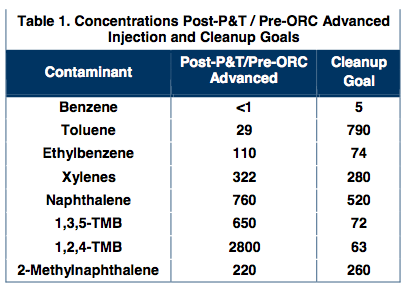
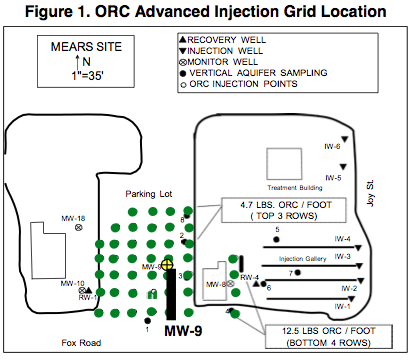

RESULTS
Pump & Treat Results
An increase in rainfall during certain parts of the remedial period contributed to some of the increases observed in Graph 1. During wet periods, an increase in concentrations resulted from the mobilization of contaminants within the capillary fringe smear zone. An infiltration gallery was installed to flush the contamination into the dissolved-phase where it was available for P&T removal.
Prior to shutdown in November 2003, O&M costs were increasing and low-level dissolved- phase concentrations were still elevated indicating the system was not effective at reaching the required low cleanup levels.
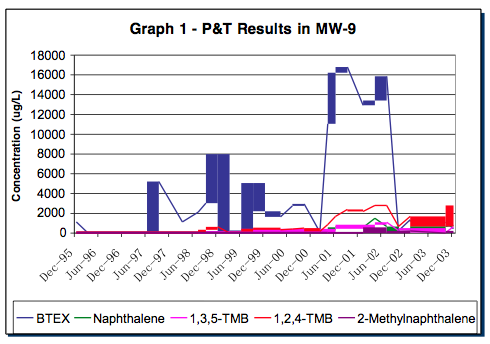
ORC Advanced Injection Results
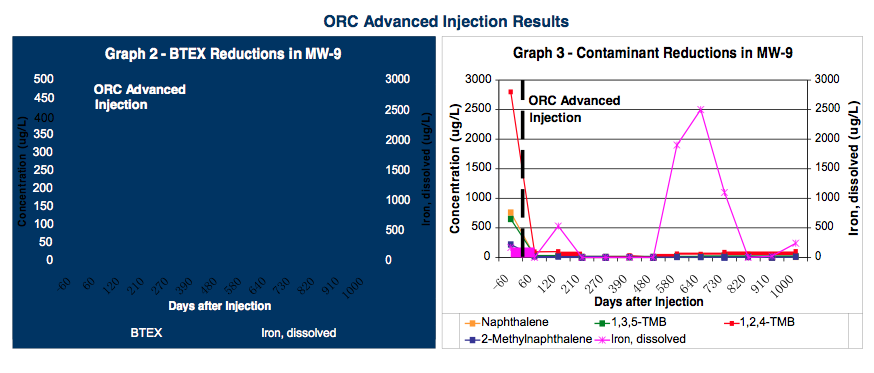
ORC Advanced Injection Results
Within 60 days of the ORC Advanced application, low-level concentrations were significantly reduced below post-P&T levels. Reduction continued throughout the monitoring period and a 99% mass reduction was achieved approximately 13 months after the initial injection. In well MW-9, concentrations in all contaminants were reduced to below the cleanup goals.
The ORC Advanced application eliminated increasing O&M costs of an aging P&T system and allowed the site to be closed years ahead of projections.
High Benzene Concentrations Reduced Using ORC Advanced
SITE SUMMARY
Elevated levels of petroleum hydrocarbons were discovered near the former dispenser island at a former service station in Sheboygan, WI. In hopes of reducing concentrations, soil excavation activities took place in June 2003. A total of 500 tons of hydrocarbon-impacted soils were removed and transported to a landfill for disposal. However, residual contamination continued to affect the groundwater after the excavation. By March 2004, benzene and ethylbenzene had risen to 2,500 ug/L and 1,300 ug/L, respectively. In Situ bioremediation using ORC Advanced was chosen to reduce BTEX, naphthalene, and trimethylbenzenes. In the northwest corner of the site, the location of the former UST basin, a total of 480 pounds of ORC Advanced was injected. In the southeast corner, the area of highest contamination, a total of 2,370 pounds of ORC Advanced was injected.
REMEDIATION APPROACH
- Remediation Objective: Reduce concentrations of Benzene to cleanup goals at the entire site. See Table 1.
- Application Type: Grid
- Product: ORC Advanced
- Quantity Applied: 2,850 lbs
- Application Rate: NW Corner–4 lbs/ft; SE Corner-11.9 lbs/ft
- Injection Spacing: 10 ft
- Product Cost: $24,225
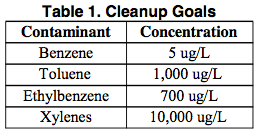
SITE CHARACTERISTICS
- Name: Former Marathon Unit #3697
- Location: Sheboygan, WI
- Industry: Service Station
- Contaminants of Concern:
Hydrogeology
- Treatment Area: NW Corner 1,200 ft2; SE Corner 1,800 ft2
- Soil Type: Silty sand lenses in clay matrix
- Groundwater Flow Direction: Southeast
- Depth to Groundwater: 12-15 ft
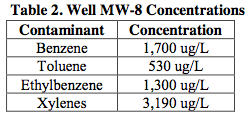
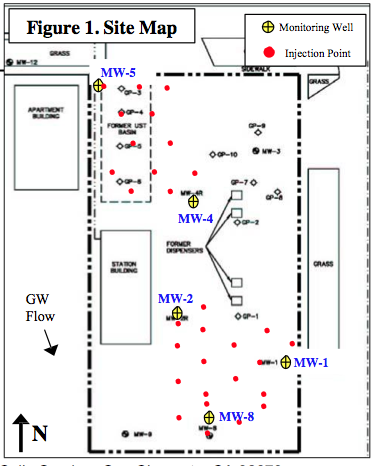
RESULTS
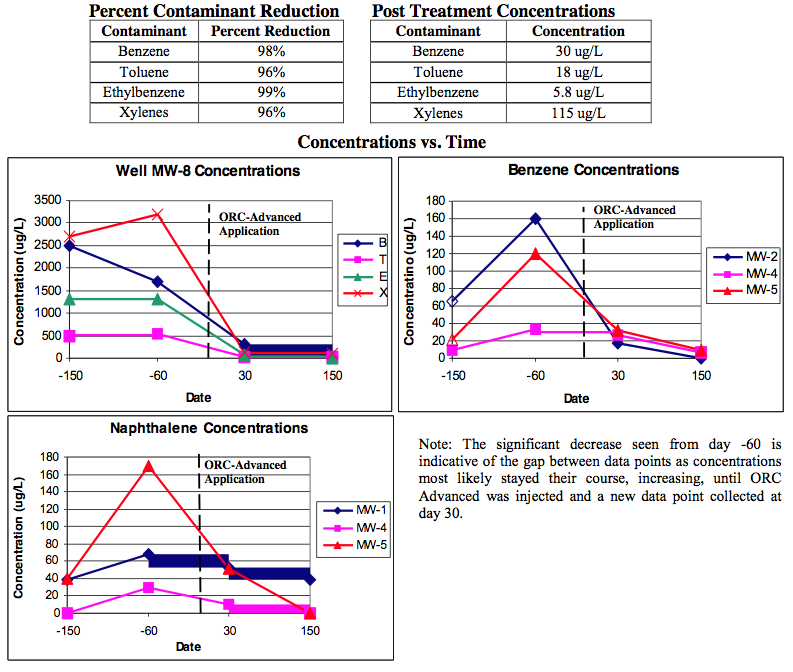
CONCLUSION
Groundwater sampling results after excavation activities show an increasing trend of contamination. On average, concentrations continued to increase up until the ORC Advanced application due to residual contamination. Concentrations peaked before ORC Advanced injection followed by a significant reduction across the plume. In well MW-5, benzene spiked to 160 ug/L while naphthalene rose to 170 ug/L and in well MW-4 BTEX, naphthalene and trimethylbenzenes all increased. Significant decreases of all contaminants were seen shortly after ORC Advanced injection. In well MW-8 total BTEX was reduced from 6,720 ug/L to 168.8 ug/L, a 97% reduction. Naphthalene concentrations were above the MCL of 20 ug/L in wells MW-1, MW-4, MW-5. ORC Advanced reduced concentrations to non-detect in wells MW-4 and MW-5, leaving 38 ug/L in well MW-1. Monitoring is on-going as concentrations continue to decrease towards MCLs.
Surgical Site Closure – 30 Sites in Indiana Receive Closure using ORC
CASE SUMMARY
Surgical Site Closure
The “Surgical Site Closure” strategy was developed by Mr. Steve Sittler, an employee of KERAMIDA in Indianapolis, Indiana. The method is an innovative remedial strategy designed to intelligently integrate natural attenuation, risk-based cleanup goals and focused source removal/treatment to cost-effectively remediate contaminated areas. This approach is best applied at sites where released materials are amenable to biodegradation and where long-term, natural attenuation-type strategies are not suitable for reasons of property transfer or potential off-site liability. This strategy was performed at 30 sites in Indiana for a major oil company.
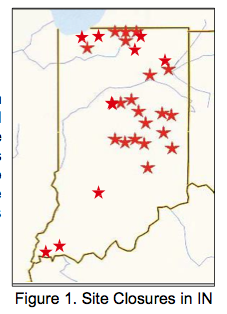
Service Stations/Bulk Storage Terminals – Indiana
From 1998-2008, a total of 30 service station/bulk storage terminal sites were targeted for Surgical Site Closure in Indiana. The subsurface matrix consisted of unconsolidated sediments ranging from low-permeability silty clays with sand stringers to sand and gravel formations. The contaminants of concern were primarily gasoline and diesel fuel. A combination of source removal via excavation coupled with enhanced in situ bioremediation using Oxygen Release Compound (ORC®) was performed at most sites.
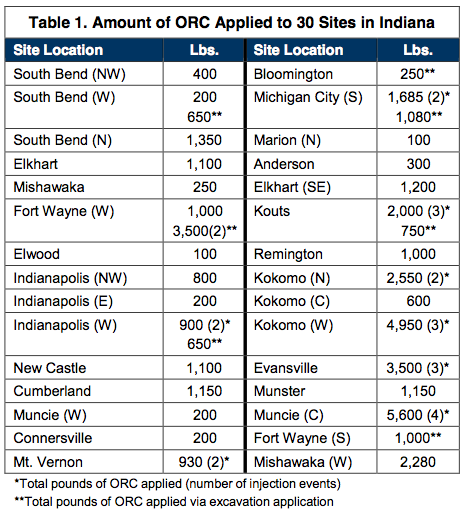
REMEDIATION APPROACH
The remediation approach included focused soil excavation of the source area and/or ORC direct-push injection. At some sites ORC was applied to the base of the excavation prior to backfilling. Shortly afterwards, a direct-push injection of ORC was completed over the remainder of the plume. The amount of ORC needed at each site location was determined using various site characteristics including contaminant concentration, seepage velocity, and treatment area.
The majority of the sites were successfully treated using only one injection of ORC; however, a handful of sites received multiple applications. Most of these sites indicated that high levels of BTEX were present prior to treatment (>1,000ppb to <50,000ppb) and required additional applications to sustain aerobic bioremediation.
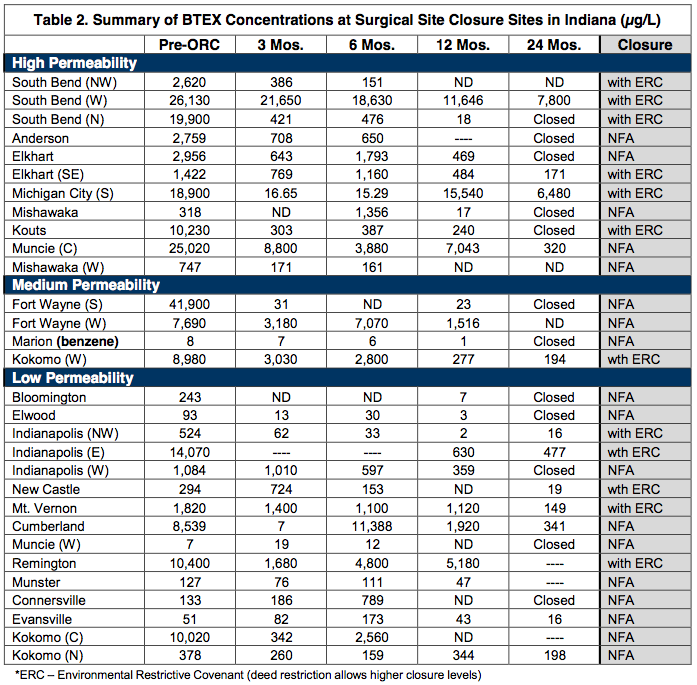
ABOUT THE CONSULTANT
![]() KERAMIDA Inc. is an engineering and consulting firm that serves industries, businesses, cities, and governments worldwide. They provide strategy and implementation services in: Sustainability, Green House Gases, Energy, Environmental Compliance, Remediation, Environmental Due Diligence, Brownfield Redevelopment, Plant Decommissioning, Health & Safety, Training, Risk Management, and ISO Management Systems. Established in 1988, KERAMIDA is headquartered in the historic Lockerbie Square district of Indianapolis, Indiana. The firm employs over 70 technical experts and support personnel in offices throughout the U.S., including Chicago, IL; Pittsburgh, PA; New York, NY; Los Angeles, CA, Sacramento, CA. KERAMIDA’s many principals have worked for over 25 years in the sustainability, environmental, health & safety, and remediation arenas, and are recognized leaders in their fields. Their engineers, scientists, and planners are renowned for delivering creative, integrated EHS solutions to a broad range of clients throughout the U.S. and abroad.
KERAMIDA Inc. is an engineering and consulting firm that serves industries, businesses, cities, and governments worldwide. They provide strategy and implementation services in: Sustainability, Green House Gases, Energy, Environmental Compliance, Remediation, Environmental Due Diligence, Brownfield Redevelopment, Plant Decommissioning, Health & Safety, Training, Risk Management, and ISO Management Systems. Established in 1988, KERAMIDA is headquartered in the historic Lockerbie Square district of Indianapolis, Indiana. The firm employs over 70 technical experts and support personnel in offices throughout the U.S., including Chicago, IL; Pittsburgh, PA; New York, NY; Los Angeles, CA, Sacramento, CA. KERAMIDA’s many principals have worked for over 25 years in the sustainability, environmental, health & safety, and remediation arenas, and are recognized leaders in their fields. Their engineers, scientists, and planners are renowned for delivering creative, integrated EHS solutions to a broad range of clients throughout the U.S. and abroad.
CONCLUSION
The Surgical Site Closure method was successful in reaching site closure at 30 petroleum-impacted sites over a nine-year period. The average time to reach site closure was ~3 years and the average cost to implement the remedial strategy was ~$70,000. Cost analyses indicated that a traditional remediation approach would have ranged from at least $100,000 to potentially $1 million. Actual implementation costs for the Surgical Site Closure approach ranged from approximately $25,000 to $75,000 plus monitoring costs.
Successful Pilot Test Results in Full-Scale Treatment of Large BTEX Plume
CASE SUMMARY
Refueling Station – Algonquin, IL
Leaking underground storage tanks at a refueling station resulted in a benzene, toluene, ethylbenzene and xylene (BTEX) plume in the underlying sand/gravel aquifer. The plume covered 1-acre and extended 390 feet downgradient from the source area, with a total BTEX concentration exceeding 24,000 parts per billion (ppb). In an effort to mitigate the source, 795 cubic yards of contaminated soil was excavated; however, further groundwater monitoring revealed that BTEX concentrations still exceeded the Illinois EPA cleanup levels. To address the remaining contamination and reduce concentrations to the state cleanup goal, a remediation plan was implemented using Oxygen Release Compound (ORC®) and ORC Advanced®.
REMEDIATION APPROACH
The remediation objective was to reduce petroleum hydrocarbon contamination, mainly benzene, to the state cleanup goal. A pilot test was performed using ORC to observe the effectiveness of reducing BTEX concentrations. Successful reduction was achieved within 4 months and a full-scale application was implemented. The full-scale application was focused near the source area as well as within the mid-plume area (near MW-7 & MW-8). Two applications followed within the mid- and lower plume areas to continue BTEX reduction.
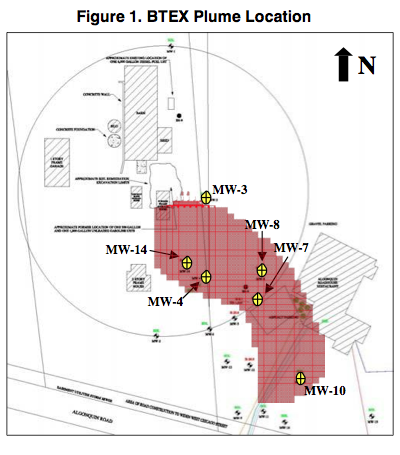
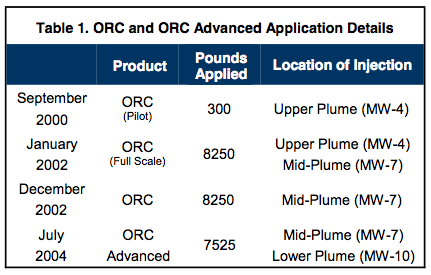

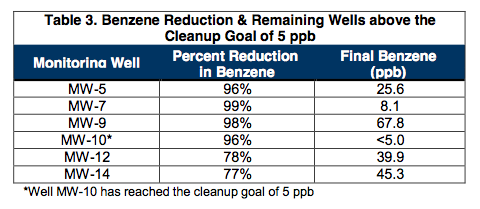
- Application Type: Grid & Barrier Application
- Soil Type: Clay above Sand/Gravel
- Groundwater Velocity: 0.25 ft/day
- Treatment Area: 43,500 ft2
- Injection Spacing: 10–20 feet
- Product Cost: $171,600
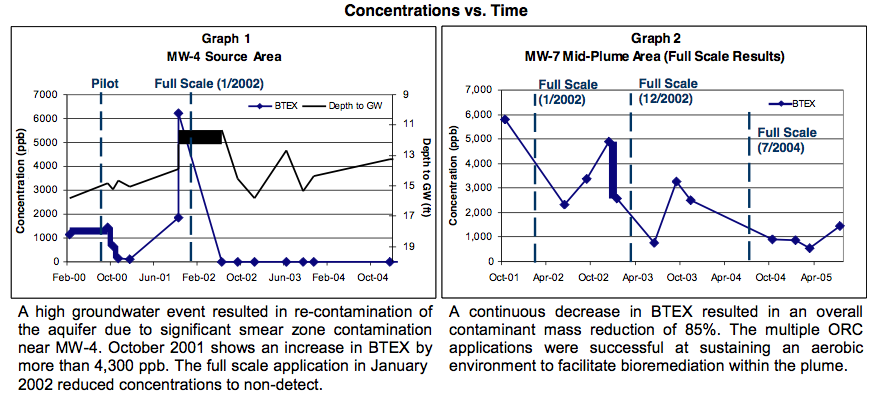
Five of the ten contaminated monitoring wells achieved the remedial objective for benzene as well as all other contaminants following the ORC and ORC Advanced injection. Benzene reduction for those wells that have not yet achieved the cleanup goal are listed in Table 3. Overall, a benzene mass reduction of over 95% was achieved. It is expected that the remaining contaminant concentrations will reach cleanup goals as monitoring continues.
Site Closure Sought after using ORC® Biobarrier to Enhance Aerobic Biodegradation of MTBE and TPHg
CASE SUMMARY
Former Service Station – Bishop, CA
Extensive methyl tertiary-butyl ether (MTBE) and total petroleum hydrocarbons as gasoline (TPHg) contamination was discovered within the subsurface as a result of leaking underground storage tanks (USTs) at a former service station. Following the removal of the leaking USTs, a total of 1,192 cubic yards of gasoline- impacted soil in the source area was excavated and transported off-site for treatment. Monitoring following the excavation activities revealed residual source contamination found in the capillary fringe immediately downgradient near Wells MW-6 and MW-7. Concentrations in Well MW-6 exceeded 7 parts per million (ppm) MTBE and approximately 11 ppm TPHg. Efforts to further delineate the plume revealed petroleum contamination extending 1,700 feet downgradient from the source. Early efforts were made to treat the downgradient plume utilizing an air sparging/vapor extraction system placed 800 feet downgradient from the site of the original release. This approach proved to be effective as MTBE and TPHg were reduced to non-detect levels downgradient from where it was installed. However, the source area continued to reveal MTBE and TPHg concentrations above the cleanup goals enforced by the California Regional Water Quality Board. To treat the source area and bring the site to closure, an enhanced bioremediation barrier (biobarrier) was designed and implemented using Oxygen Release Compound (ORC®).
REMEDIATION APPROACH
To address the source area, a total of 950 pounds of ORC was mixed with water to form a slurry and injected via direct-push technology. The 3 row ORC biobarrier was applied immediately downgradient from the release area (Figure 1). Wells MW-6 and MW-7 were monitored to observe the effectiveness of ORC.
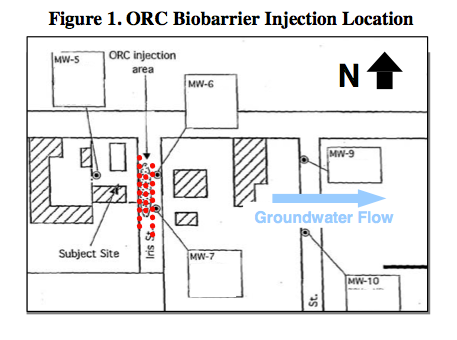
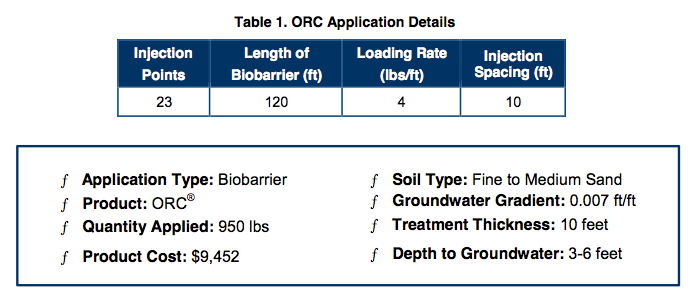
RESULTS
The post-ORC injection monitoring results show an effective reduction of MTBE and TPHg within one year. Well MW-6 indicates two MTBE concentration spikes likely caused by residual contamination from the soil entering into the groundwater (Graph 1). However, an MTBE reduction of 94% occurred between day 210 and 300 and concentrations reached non-detect shortly afterwards. TPHg concentrations declined by 70% within the first 30 days and continued on a downward trend, reaching non-detect levels approximately one year after the application.
In Well MW-7, reduction occurred immediately after injection with an MTBE decrease of 88% by day 120 (Graph 2). Concentrations reached non-detect less than a year after the ORC application. TPHg levels declined similarly to MTBE and reached non-detect in less than one year.
The effective treatment of MTBE and TPHg using ORC resulted in non-detect levels of both contaminants and has allowed the consultant to seek site closure status from the regulatory agency.
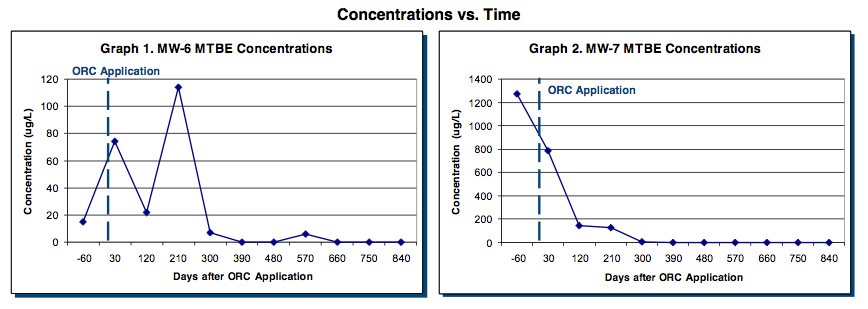
In Situ Aerobic Bioremediation vs. AS/SVE Cost Comparison at UST Site
REGENESIS® Demonstrates Effective Cost-Savings Using ORC®
Project Highlights
- An in situ aerobic bioremediation pilot test demonstrates a cost-effective treatment option vs. traditional Air Sparge and Soil Vapor Extraction (AS/SVE) system
- Within one month, benzene concentrations were reduced from baseline concentrations of 200 ug/L to non-detect (>5 ug/L)
- Approach using ORC® resulted in a $79K savings vs. traditional mechanical treatment option
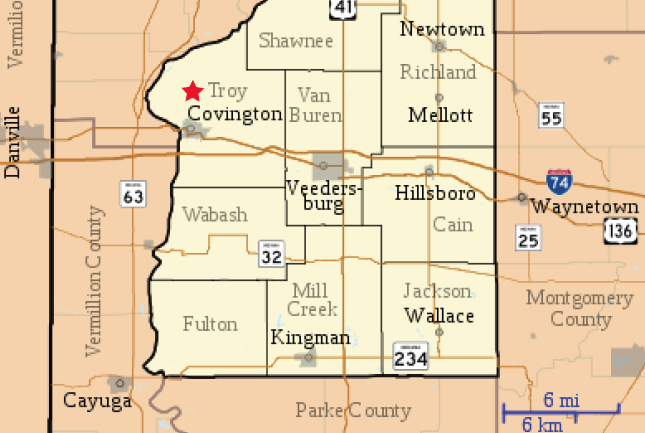
Project Summary
The site of a former gas station with leaking underground storage tanks (LUSTs) was chosen for a pilot test to demonstrate the effectiveness of ORC® in treating the existing benzene (BTEX) and MTBE concentrations. In addition to the pilot test, a cost-comparison was also prepared to illustrate the potential for cost-savings associated with the use of a passive, innovative technology like ORC vs. a traditional AS/SVE remediation system.
For the pilot test a 20 ft. x 20 ft. area, with the highest concentrations of BTEX and MTBE, was treated with 180 lbs of ORC. BTEX concentrations within this area varied from 200 ug/L to 2100 ug/L from low and high groundwater elevation, respectively. ORC was injected into 10 points from 8-14 ft bgs to ensure ample coverage of the sand layer and some of the smear zone.
Technology Description
Oxygen Release Compound (ORC) is an engineered, oxygen release compound designed specifically for enhanced, in situ aerobic bioremediation of petroleum hydrocarbons in groundwater or saturated soils.
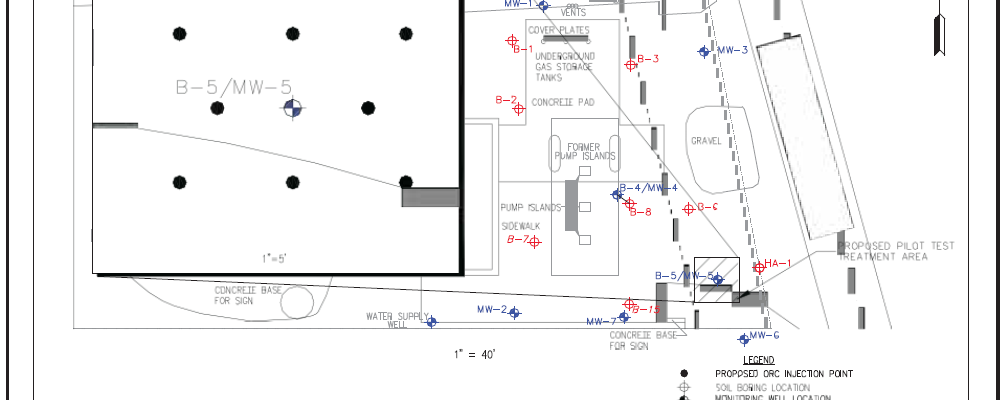
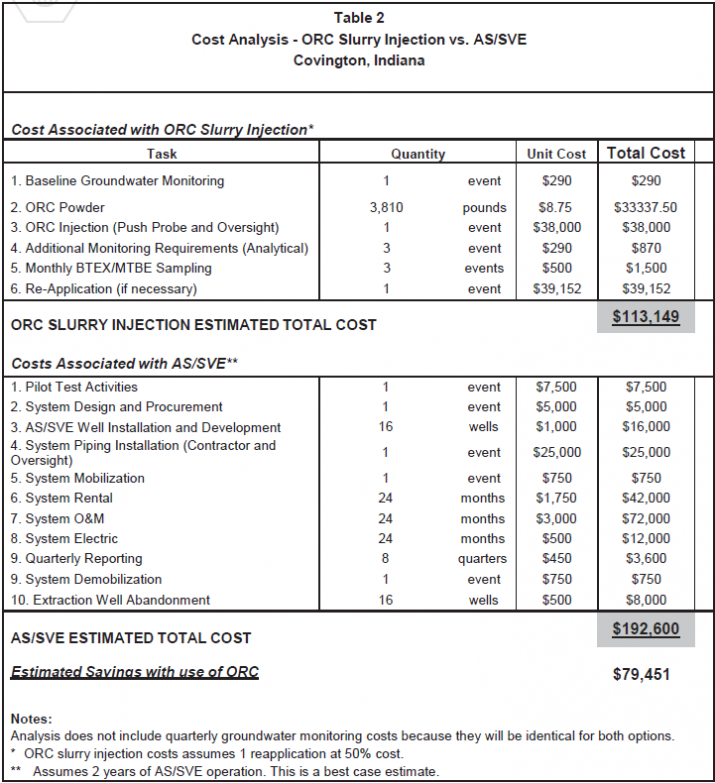
Cost Comparison Analysis
A cost comparison analysis was prepared by the consultant for the Indiana Department of Environmental Management (IDEM) to show a comprehensive cost savings using ORC versus the AS/SVE system for full-scale treatment of benzene and MTBE. This cost comparison is illustrated in Table 2 and includes the initial full-scale ORC application costs as well as a second application at 50% of the initial application cost. This second application is shown as an “insurance policy” in the event that more ORC is needed to complete the remediation. The AS/SVE costs are reflective of the design, installation, and operation of such a system for two years. Based on the analysis, the use of ORC represents ~59% of the cost of the AS/SVE option or a potential savings of $79,451. If a second insurance application is avoided, then the savings are $79,451 (initial saving) plus $39,1529 (cost for re-application) equaling $118,603.
Results
Within one month, benzene concentrations in the low groundwater elevation were reduced from baseline concentrations of 200 ug/L to non-detect (<5 ug/L). Dissolved oxygen content also increased dramatically from <0.5 ppm (baseline) to >20 ppm post application. A successful full-scale application was designed using 4,000 pounds of ORC, which will save the client >$79K versus a traditional AS/SVE system.
Petroleum Hydrocarbon and Chlorinated Solvent Treatment Using PersulfOx™ at a Former Service Station
Overview
Petroleum hydrocarbons and chlorinated compounds were discovered in groundwater at a former gasoline service station/auto-repair facility. This redevelopment site, located in Bronx County, New York, previously housed an underground storage tank (UST) used for gasoline storage. Following the discovery of groundwater contamination in excess of NYSDEC groundwater protection standards, the UST and soils were removed to bedrock at a depth of 11 feet. Further monitoring revealed toluene and benzene contamination as well as tetrachloroethene (PCE) and trichloroethene (TCE) impacts from parts cleaning associated with the on-site auto-repair shop. Remedial action was required to restore site groundwater and make way for redevelopment and construction of a new building. In Situ chemical oxidation (ISCO) using PersulfOxTM was chosen as the remediation approach.
- PersulfOx is a persulfate based ISCO reagent that promotes rapid and sustained in situ oxidation of a wide-range of organic contaminants.
- This patented technology utilizes a unique catalytic surface on which oxidants and contaminants react in a process known as “surface mediated oxidation.”
- PersulfOx also contains built-in activation which eliminates complex and potentially hazardous chemical addition required to achieve traditional persulfate activation.
- From a health and safety aspect, the use of PersulfOx alone is safer than traditional activation methods such as heat, chelated metals, hydrogen peroxide or base.
- If warranted, PersulfOx can also be activated through traditional means to achieve site remediation goals.
The ISCO treatment system consisted of a series of pipes extending below the basement level of the existing slab for the specific purpose of delivering PersulfOx directly onto the bedrock surface. The pipes terminated into dispersion pits scraped into the bedrock allowing PersulfOx to pool and enter the fractures (Figure 1). The ISCO delivery system design allowed for multiple reagent applications as often as required to complete the remediation process.
Current trends in the available monitoring well data indicate significant reductions in total VOCs (Figure 2).
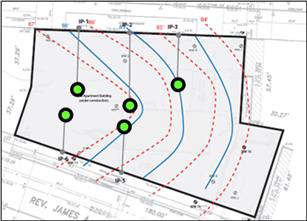
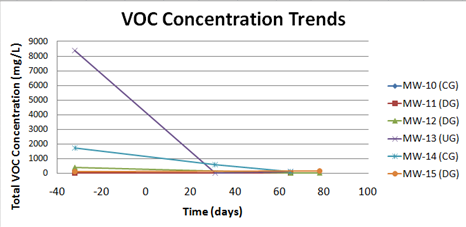
CASE STUDY: SOIL BOUND BTEX TREATMENT AND ACTIVE REMEDIATION SYSTEM INTEGRATION
Purpose:
The purpose of this pilot study was to demonstrate the feasibility of using PetroCleanzeTM to desorb petroleum contaminants from the soil into the dissolved phase where they can then be treated by physical extraction or an active remediation system.
Background:
A biosparge system was used at the site until groundwater concentrations dropped below cleanup target levels (approximately 2 years), then it was shut down. Rebound occurred during post-active remediation monitoring and groundwater concentrations increased above natural attenuation default concentrations. The observed increase in dissolved contaminant concentrations, combined with high organic vapor analyzer readings in saturated soil samples, and elevated fraction of organic carbon and total organic carbon concentrations in the soil, suggested petroleum contamination was likely absorbed to organics in saturated soils and was slowly desorbing into the groundwater. An approach was needed to liberate bound hydrocarbons for additional treatment using the biosparge system.
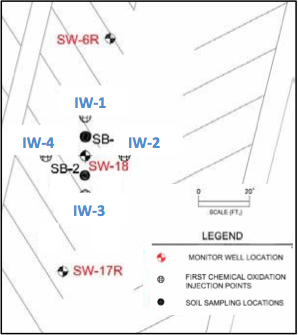
Pre-Injection Baseline Analytical:
On January 12, 2012, baseline groundwater samples from monitoring wells SW-6R, -17R, and 18 (Figure 1) were collected for BTEX (benzene, toluene, ethylbenzene, xylene) and TRPH (total recoverable petroleum hydrocarbons) analysis (Figure 3, 4). On January 13, 2012, two soil borings (SB-1 and SB-2) were completed and baseline soil samples were collected from 12-14 feet below land surface for BTEX analysis (Figure 2). Figure 2 shows the average soil BTEX concentration for SB-1 and SB-2 before and after PetroCleanze injection.
PetroCleanze Injection:
On February 2-3, 2012, a total of 2,220 gallons of 5% solution of PetroCleanze was injected into four injection points surrounding SW-18. Each point received a total of 550 gallons of solution, including 220 lbs of RegenOx Part A, 240 lbs of PetroCleanze, and 500 gallons of water. The biosparge system was reactivated for the duration of the treatment event.
Post-Injection Analytical:
On March 12, 2012 and July 10th, 2012, groundwater samples from groundwater monitor wells SW-6R, -17R, and -18 were collected for BTEX and TRPH analysis (Figure 3, 4). Also on March 13th and July 23rd, 2012, two soil borings (SB-1 and SB-2) were completed and soil samples were again collected for BTEX analysis (Figure 2).
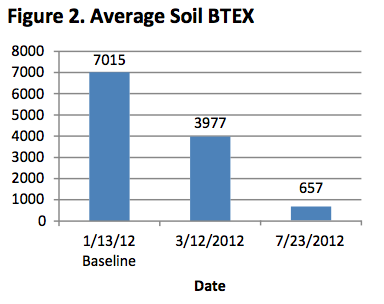
Results:
Performance parameters were evaluated for SW-6R, -17R, and -18 and a marked increase in ORP values was observed in each of the three wells following the PetroCleanze injection indicating chemical oxidation activity. Additionally, the pH in wells SW-17R and -18 increased significantly, providing evidence that alkaline conditions resulted from the application of PetroCleanze. As anticipated, increases in TRPH and BTEX concentrations in the sampled wells were observed following PetroCleanze injection as compared to baseline (Figure 3, 4). SW-17R was slightly unique in that BTEX concentrations went down. When looking at the average soil BTEX concentration of the two soil samples (Figure 2) in January, March, and July 2012 (7,015, 3,977, and 657 μg/kg, respectively) there was a 43% reduction between January and March and a 91% reduction between January and July 2012 after continued biosparging treatment.


Conclusion and Recommendations:
The PetroCleanze application was successful and the material easily applied. Performance exceeded expectations as only one injection was needed to strip 91% of the BTEX contamination from the soil into the dissolved phase. The reactivated biosparge system was able to treat the increased dissolved phase contaminants in the treatment area.
The current groundwater concentrations at the site are very low in key monitoring wells; therefore, the project does not require additional treatment at this time. However, should a change in contaminant concentration be observed at the site once active remediation has been ceased then additional treatment will be considered.
Combined Remediation Approach – Dual Phase Vacuum Extraction with In Situ Chemical Oxidation
Introduction
When redevelopment of an old service station was proposed, site investigations revealed a significant petroleum hydrocarbon impact within the soil and groundwater. The subsurface contamination threatened to derail the redevelopment program and a rapid remediation strategy was needed to reduce concentrations to acceptable levels. Geo2 Remediation was contacted to remediate the site in order to allow safe development for luxury residential properties while ensuring no impact to local protected controlled waters.

Figure 1. Successful Site Remediation Leads to Luxury Residence Redevelopment
Project Background
Geo2 Remediation carried out the treatment of a former service station following historic leakage from underground storage tanks (USTs). The tanks had been removed prior to the beginning of the site investigation. Free product was discovered at the surface of the saturated zone and elevated concentrations of total petroleum hydrocarbons (TPH) were observed within the groundwater. Concentrations of TPH as high as 290 mg/L were discovered within the source area.
In Situ Physical Remediation
Geo2 Remediation installed a dual phase vacuum extraction (DPVE) system, designed to rapidly remove phase separated product identified on the surface of the groundwater. The DPVE system began treatment in September 2007. Thicknesses of free product up to 50mm, identified around the former tank farm, were removed within 1 month of commencing treatment. Within the groundwater, TPH concentrations were reduced to between 300 mg/L and 150 mg/L over a 5-month monitoring period. In order to increase the efficiency of the DPVE system, Geo2 augmented the physical treatment system with RegenOx to provide a rapid reduction in soil and groundwater concentrations and allow redevelopment to proceed on schedule.
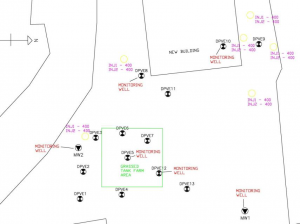
Combined In Situ Physical Remediation and Chemical Oxidation
Geo2 Remediation applied RegenOxTM, a safe and easy to apply proprietary in situ chemical oxidation (ISCO) designed to provide rapid concentration reduction of contaminants without a violent exothermic reaction or other handling difficulties common to ISCO reagents. RegenOx was injected into the subsurface around the dissolved phase impact following DPVE system shutdown using a direct-push injection rig. Two applications were completed within one week of each other using a modest dose of 326 kg RegenOx to achieve sorbed-phase desorption and partial chemical oxidation of the residual hydrocabons. The DPVE system was then restarted to remove the resulting desorbed contamination and partially oxidised hydrocarbon species from the groundwater – this enabled the Reagent requirements to be kept to a minimum (i.e. partial contaminant oxidation rather than full contaminant oxidation) whilst capitalising on the use of the DPVE system already in place. The total cost of the RegenOx application – including all fieldwork – was approximately £ 5,000, the cost of one month’s DPVE operation at the site.
RegenOx® Basics
RegenOx® is a proprietary two-part chemical oxidation product developed and sold by Regenesis for in situ groundwater treatment. It combines the use of a controlled-release percarbonate-based oxygen compound with a proprietary multi-part catalyst to generate surface-mediated free-radical generation and contaminant oxidation (e.g. perhydroxyl radical, hydroxyl radical and superoxide radical), with reactive power comparable to that of Fenton’s reagent but with greatly facilitated handling and subsurface delivery / longevity (up to 30 days). This provides an effective contaminant oxidation reaction without violent exothermic reaction, and can therefore be handled using a wide range of standard field equipment (e.g. direct push injection rigs) or applied directly to excavations. Furthermore, it is alkaline and can therefore be used in calcareous formations in addition to sands and gravels etc.
RegenOx-enhanced Contaminant Desorption
RegenOx has been designed as a bespoke remediation product to provide advantages in usage and application over commodity chemical products used for ISCO (e.g. permanganates, persulphates, peroxides). One of the design features it includes is reduced losses onto the aquifer matrix, commonly known as the matrix Natural Oxidant Demand (NOD). This is achieved by RegenOx through a powerful desorption / surfactant effect of the combined product (principally the catalyst) that draws the contaminant off the soil surface and into solution / onto the catalytic surface where localised free-radical generation occurs leading to focused contaminant destruction. This restricts the oxidant losses onto tightly bound and heavier soil organics such as humics, roots, and other natural or immobile fractions. At the same time, RegenOx is purely inorganic therefore adding no organic surfactant to the system that may prevent a competitive oxygen sink to on-going contaminant biodegradation.
The present project makes use of this product feature to combine in situ chemical oxidation with enhanced physical mass recovery. RegenOx-desorbed contaminant mass and partially oxidised (more soluble) organic species are recovered via groundwater abstraction using the DPVE system, whilst further contamination is destroyed in situ by oxidation.
Results
Upon completing the RegenOx applications, desorption from the highly impacted soils produced a temporary increase in groundwater hydrocarbon concentrations to a maximum of 4,800 mg/L. One week after the second application was completed, the DPVE system was re-started, rapidly reducing the TPH concentrations in the groundwater to an average of 20 mg/L. The improved efficacy of the DPVE system can be seen in Graph 1 where the linear trendline of MW-2 before and after the RegenOx applications shows a conservative 80% reduction in contaminant concentrations within two months – effectively increasing the DPVE efficiency by more than 500% at this stage in its operation. Once the DPVE system was switched off, further monitoring showed that there was no rebound in groundwater hydrocarbon concentrations due to the augmentation process successfully reducing the sorbed TPH concentrations of the soils.
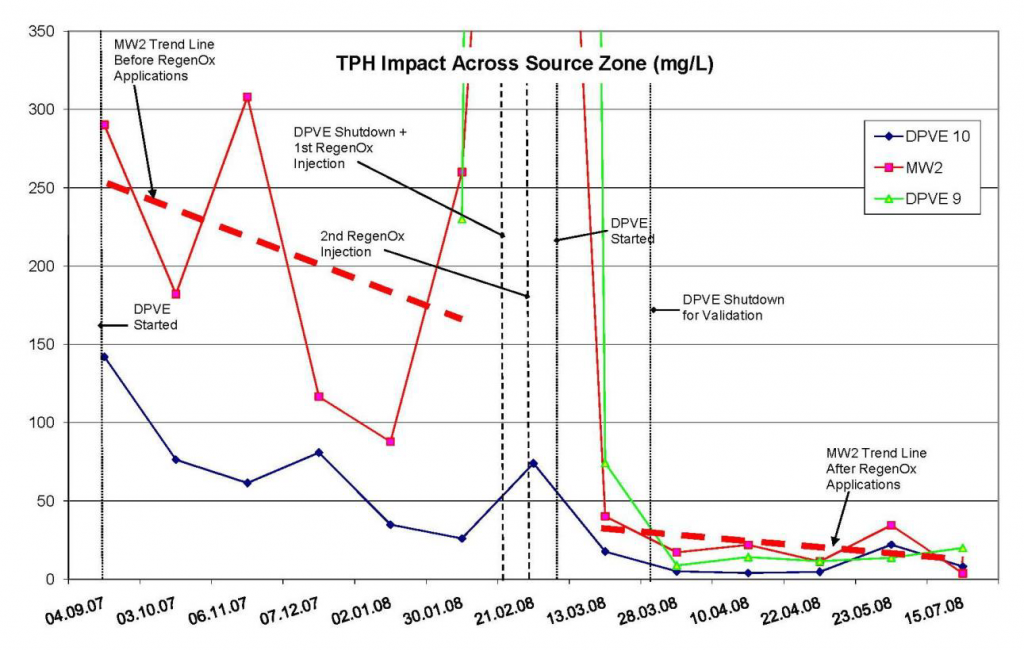
RegenOx Treats #2 Fuel Oil Plume Beneath Residential Home
CASE SUMMARY
Home Heating Oil, New Jersey
A 550-gallon leaking underground storage tank (UST) containing #2 fuel oil was removed from a single family residence in New Jersey (Figure 1). In addition, the surrounding soil was excavated and sampling was performed to determine the extent of the petroleum hydrocarbon plume within soil and groundwater. The plume was delineated at approximately 1,800 ft2 with
concentrations of total petroleum hydrocarbons as high as 40,000 parts per million (ppm) in soil and approximately 40,000 parts per billion (ppb) in groundwater. An estimated 20% of the plume was determined to be located beneath the home itself, eliminating the option for extensive soil excavation. Other remedial strategies such as pump & treat, monitored natural attenuation, and enhanced fluid recovery were ruled out as they did not provide a timely, cost-effective solution.
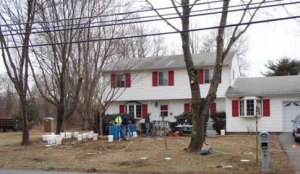
Figure 1. Residential Site
- Soil Type: Fine to Medium Sands
- Treatment Thickness: 5 to 12 feet bgs
- Free Product: 1” to 3” observed
- Contaminants of Concern:
- TPH – Total Petroleum Hydrocarbons
- TVOC – Total Volatile Organic Carbon
- TSVOC – Total Semi-Volatile Organic Carbon
| Contaminant | Concentration |
| TPH – soil | 40,000 ppm |
| TVOC – gw | 7,900 ppb |
| TSVOC – gw | 40,000 ppb |
REMEDIATION TECHNOLOGY
In Situ chemical oxidation (ISCO) using RegenOxTM was chosen as the most appropriate technology to treat the soil and groundwater plume. In addition, an application of a slow-release oxygen compound, ORC Advanced®, was applied following RegenOx to stimulate aerobic biodegradation of any residual contaminants. RegenOx was applied based on the following:
- Least disruptive to the homeowner
- Successful track record
- Feasible site conditions – sandy soils and a shallow water table paired well with direct-push injection
- Low natural organic carbon in saturated zone
- Safe to use and easy to apply
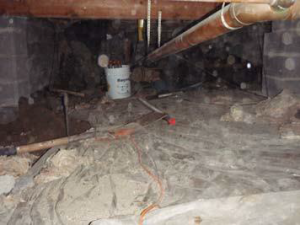
Ten permanent injection points were installed around the source area, at the edge of the plume and beneath the house in the crawl space as seen in Figure 2. During the installation, free phase product was observed in monitoring wells at approximately 1 to 3 inches. The NJDEP’s Permit-by- Rule prohibited the injection of any remediation technology should free product be present. Once the removal was complete, RegenOx could be applied as designed.
CONTAMINANT PLUME TREATMENT
Free Product Removal
The free product was removed using a mild surfactant and a high powered vacuum extraction truck within the source area. This process also effectively distributed the surfactant across the impacted zone for further desorption of contaminants from the soil matrix. Three free product recovery events were performed which effectively removed all free product from the wells and surrounding areas. TVOC concentrations in groundwater dropped only slightly as a result of the free product removal. However, concentrations of TSVOCs more than doubled in groundwater as a result of desorption from soil.
ISCO Injection for TPH Reduction
The application design included two RegenOx injection events and a third combined RegenOx and ORC Advanced injection for on-going biostimulation to treat residual contaminants. Using temporary and permanent injection points, a total of 6,210 pounds of RegenOx was applied from 5 to 11 feet bgs. The third injection included 650 pounds of ORC Advanced.
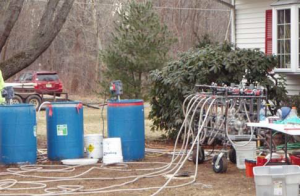

Conclusion
No free product, sheen or film was observed after the injections were completed (Figure 5). Levels of dissolved oxygen 30 days following the final application were measured at approximately 10-20 ppm indicating the presence of ORC Advanced in the subsurface.
Within 6 months, significant reductions in petroleum hydrocarbons were observed. TVOCs declined from 7,900 to <50 ppb and TSVOCs were reduced from 40,000 to <150 ppb. Further Action status from the NJDEP. The site is currently seeking No Further Action status from the NJDEP.
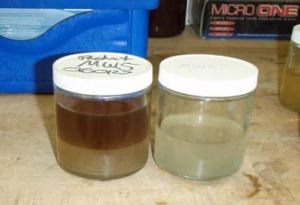

 Americas
Americas Europe
Europe Français
Français Deutsch
Deutsch Italiano
Italiano Español
Español




